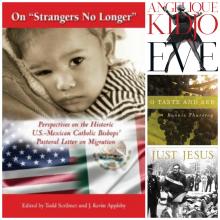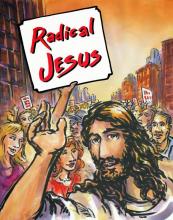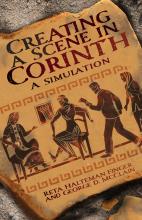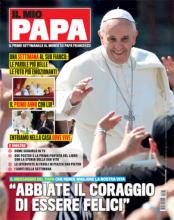Culture

The Spirit’s Work
Just Jesus: My Struggle to Become Human, by Walter Wink with Steven Berry, is the final book by the late, influential Christian thinker. It blends brief autobiographical vignettes with essays on key themes in Wink’s work, offering insights into how his life story shaped his faith, thought, and witness. Image
Border Truths
On “Strangers No Longer”: Perspectives on the Historic U.S.-Mexican Catholic Bishops’ Pastoral Letter on Migration is a collection of essays by scholars and policy experts that uses the 2003 pastoral letter on immigration “Strangers No Longer: Together on the Journey of Hope” as its starting point. Paulist Press

THE GRAPHIC NOVEL Radical Jesus, edited by Paul Buhle, has three distinct sections offering different expressions of Jesus’ life and social message. The brevity of the graphic novel medium allows the writers to construct a clear and distinct message in a moving art form.
Part one, “Radical Gospel,” illustrated by Sabrina Jones, uses biblical quotes to construct a visual story that connects the words of Jesus to modern situations. The black and white ink styling is simple yet profound.
While Jesus and his disciples are portrayed as first century Jews, the people Jesus interacts with and tells parables about are all in modern dress. This puts Jesus in an accessible conversation not only with his disciples, but also with the reader. In a collection of Jesus’ sayings from the Sermon on the Mount, the art drives home the emotional impact of his words.
Jones does not shy away from the radical implications of Jesus’ message. My favorite of her modern interpretations is an image of the destruction wreaked by the 9/11 attacks, contrasted with Jesus’ reference to the temple in Jerusalem, where he exclaims, “The day will come when there isn’t one stone left on top of another that is not thrown down.”

ONE YEAR MY small group decided to have each member choose a person named or alluded to in the gospels to “follow” during Lent. We researched our people and the customs of that time and reflected individually and collectively on their encounters with Jesus. Then we hosted a community meal for family and friends on the night before Easter. Each member of our group came in character as the person we’d studied and tried to recreate the mood of that frightening, confusing, grief-filled night for followers of Jesus after his death and before his resurrection. After the meal, each of us presented a monologue that tried to project what our person might have been thinking and experiencing at that time.
The attempt to immerse mind, soul, and body into scriptures that I had listened to for much of my life (but perhaps hadn’t really heard) was a transformative experience: It burned away long-held assumptions and revealed new facets of chapter and verse.
The book Creating a Scene in Corinth: A Simulation, by Sojourners contributing editor Reta Halteman Finger and George D. McClain, provides a useful and fun toolbox for small groups, Sunday schools, religion classes, and even imaginative individuals who want their own full-immersion experience of scripture and biblical scholarship. It invites readers to a deeper understanding of the apostle Paul’s letter to the church in Corinth by using role play to “become” members of the different factions of that community as they hear Paul’s words read for the first time. The authors assert that “as we more clearly experience what Paul meant in the first century, we can better understand what his writings mean in our 21st century context.”
THE STILL, ATTENTIVE, affectionate, at times lamenting, always sagacious, well-defined, occasional poems in This Day, Wendell Berry’s most recent collection, are a magnificent gift to American letters.
For nearly 35 years Berry has kept the Sabbath holy. His practice is either unorthodox or so deeply orthodox that professional religionists may not recognize it. On Sundays Berry walks his Kentucky “home place,” the roughly 125 acres of bottom land in the region his family has farmed for more than 200 years. From the seventh-day silence, solitude, and natural world, Berry has crafted his Sabbath poems.
“Occasional poems” commemorate public events, but here Berry lays quiet markers to remember personal days in the life of one man. He writes in the preface: “though I am happy to think that poetry may be reclaiming its public life, I am equally happy to insist that poetry also has a private life that is more important to it and more necessary to us.”

ONE OF THE paradoxes of writing about film is the application of one form of language to interpret another. The medium we’re discussing here is visual, and despite the relevance of the word “poetic” to the great works of cinema, to interact with the movies means, as writer-director John Sayles says, to “think in pictures.” In an age with multiple ways to consume films, and the pressure to respond with the immediacy of social media, to think deeply about movies is a countercultural act.
I noticed this again after being given a record player a few weeks ago. I’ve listened to Van Morrison’s Astral Weeks more than pretty much any other album over the past 20 years and now on the vinyl recording I can actually hear instruments I’d never noticed before. I can’t deny the superiority of the medium, at least in terms of what we might call “musical richness.” But digital transmission makes the sound crisper and more available.
There’s a parallel paradox with cinema, in that the experience of watching films has both diminished and expanded over most of our lifetimes. There are more portals than ever (you can watch Yasujiro Ozu’s Tokyo Story or Alfred Hitchcock’s Vertigo on your phone, for goodness’ sake). Yet the opportunity to see films in optimal settings (decent projection, focused audience, without 25 minutes of commercials for soda mingling with threats of prosecution directed at the people who have paid to see the film by the industrial complex that depends on them) doesn’t come often for most of us. Without conscious resistance, the flattened culture of entertainment globalization is going to continue to dominate.

Son of God is Hollywood’s take on the life and teachings of Jesus of Nazareth. While the producers clearly tried hard to use modern filmmaking techniques to bring scripture to the big screen, the attempt fell flat somewhere between the use of action-sequences, swelling music reminiscent of old Westerns, and unconvincing acting — Jesus is played by Portuguese actor Diogo Morgado, who managed to look irritatingly self-satisfied for most of the movie.
Since faith is such a personal, spiritual experience, it begs the question: Is it possible to make the life and ministry of Jesus into a film that accurately reflects Christianity, or does such an effort cheapen beliefs?

WHEN I MOVED out of my Sojourners magazine office in 1988, I took with me two signed review copies of books. One was Roll the Union On: A Pictorial History of the Southern Tenant Farmers’ Union. It was inscribed to me personally by H.L. Mitchell, a founder of the STFU, so I felt entitled to keep it.
The other book bore no inscription, just a simple black ink signature above the Simon & Schuster logo. It was called Carry It On! A History in Song and Picture of America’s Working Men and Women, and the co-author who signed it was Pete Seeger. I’m looking at that signature now, as I write this on the day Seeger died.
I told myself that I kept that book because I thought it might come in handy. After all, it had 11 translations of “L’Internationale” and all the words to “Solidarity Forever.” But really I kept it for the signature. I liked the idea of having something that I knew had come from the hand of someone who had ridden the rails with Woody Guthrie. Seeger was our living connection to the culture of the 1930s when, for a moment, radical dreams about a country owned and operated by its ordinary citizens seemed almost ready for prime time.
Of course, that moment passed, and those dreams were shattered by the Red Scare and the Cold War that followed. But Seeger came out on the other side with his integrity and ideals intact. Despite being honored by the last two Democratic presidents, he never renounced his radical vision of what America could be. Seeger left the Communist Party in the early 1950s and frankly acknowledged that he should have done so sooner, but he never stopped calling himself a “small c” communist. In 1994, he told The Washington Post, “Our ancestors were all socialists: You killed a deer and maybe you got the best cut, but you wouldn’t let it rot, you shared it.” Still, he was a pragmatic radical, who added that socialists should recognize that “every society has a post office and none of them is efficient. No post office anywhere invented Federal Express.”
WHEN I MOVED out of my Sojourners magazine office in 1988, I took with me two signed review copies of books. One was Roll the Union On: A Pictorial History of the Southern Tenant Farmers’ Union. It was inscribed to me personally by H.L. Mitchell, a founder of the STFU, so I felt entitled to keep it.
The other book bore no inscription, just a simple black ink signature above the Simon & Schuster logo. It was called Carry It On! A History in Song and Picture of America’s Working Men and Women, and the co-author who signed it was Pete Seeger. I’m looking at that signature now, as I write this on the day Seeger died.
I told myself that I kept that book because I thought it might come in handy. After all, it had 11 translations of “L’Internationale” and all the words to “Solidarity Forever.” But really I kept it for the signature. I liked the idea of having something that I knew had come from the hand of someone who had ridden the rails with Woody Guthrie. Seeger was our living connection to the culture of the 1930s when, for a moment, radical dreams about a country owned and operated by its ordinary citizens seemed almost ready for prime time.
Of course, that moment passed, and those dreams were shattered by the Red Scare and the Cold War that followed. But Seeger came out on the other side with his integrity and ideals intact. Despite being honored by the last two Democratic presidents, he never renounced his radical vision of what America could be. Seeger left the Communist Party in the early 1950s and frankly acknowledged that he should have done so sooner, but he never stopped calling himself a “small c” communist. In 1994, he told The Washington Post, “Our ancestors were all socialists: You killed a deer and maybe you got the best cut, but you wouldn’t let it rot, you shared it.” Still, he was a pragmatic radical, who added that socialists should recognize that “every society has a post office and none of them is efficient. No post office anywhere invented Federal Express.”

ONE RECENT WINTER day, Nora Howell stepped out of her house in the Sandtown neighborhood of Baltimore and took a walk down the street. People in the predominantly black community did double takes as this white woman promenaded past them in a sundress made of saltine and oyster crackers. Some stared in disbelief. One man doubled over laughing. In the corner coffee shop, one of the regulars warned Howell not to walk by any homeless people because they might just eat her up.
Later Howell, a community artist and director of the neighborhood Jubilee Arts program, set the video footage taken during her walk to Mister Rogers’ classic refrain, “Won’t You Be My Neighbor?” The piece, which emerged out of Howell’s ponderings on what it means to be white living in a black neighborhood, became another part of her answer to a call: to use art to address systemic racism and bring about the kingdom of God.
From Race Riots to White Suburbia and Beyond
In 2001, Howell was an eighth grader living in a biracial community in urban Cincinnati. When race riots erupted after a young black man was shot fatally by a white police officer (sound familiar?), her family took to the streets on a prayer walk through the riots. Howell remembers being shocked and terrified, thinking, “Why do we still have race riots? Cincinnati is so far behind the times.”
In the aftermath, Howell talked with peers at school on the reality of racial tensions and observed with curiosity how white and black churches throughout the city responded. She realized race riots weren’t just a relic of the ’60s. “When you lived in a place where different racial groups interacted daily, [racial tensions] could no longer be denied or ignored,” she said.
Yet when Howell moved to suburban Chicago to attend Wheaton College, conversations on race were largely absent. “I found that very odd,” she said. She got involved in a campus group to promote awareness of racial injustice.

By turning water into wine, Jesus used his first miracle to keep the wedding feast going.
Jesus said to them, "Fill the jars with water." And they filled them up to the brim. He said to them, “Now draw some out, and take it to the chief steward.” So they took it. When the steward tasted the water that had become wine and did not know where it came from (though the servants who had drawn the water knew), the steward called the bridegroom and said to him, “Everyone serves the good wine first, and then the inferior wine after the guests have become drunk. But you have kept the good wine until now.” (John 2:7-10)
But maybe Jesus won't be the only one reigniting the party with homemade wine. A new device called The Miracle Machine promises to make pre-aged wine in about three days.
It’s called The Miracle Machine (of course) and it’s basically a Sodastream for wine. Like its under-21 counterpart, the Miracle Machine uses water, yeast, grape concentrate, and finishing powder packets to create decent DIY-quality vino, virtually out of thin air. Just connect the machine to its corresponding iOS or Android app, input all the ingredients, and, in true miracle fashion, wait three days for your wine to rise triumphantly from the ashes of discarded flavor packets and tap water.
Just to be clear, Jesus didn't have to wait three days for his wine.



Yes, his blood was on us once,
making us famous blades within the blades
community. I mean, many of us
had taken blood and sweat before
from lions and dogs and even fallen birds
or lovers and killers and the killed
but this was the first time we took both
at the same time, from the same creature.
You humans have that saying,
Blood, sweat, and tears. By this you signify work.
Consider the lilies of the field, he said
of our cousins. They neither work nor spin
but I tell you that not even Solomon
in all his glory was clothed like them.

Il Mio Papa, a new weekly magazine that will focus entirely on Pope Francis — complete with a weekly centerfold poster of the pontiff — is scheduled to hit Italian newsstands on Wednesday.
The magazine, whose name translates to “My Pope,” will go heavy on photography and colorful layouts, according to a news release from publisher Mondadori. It’s the first magazine entirely devoted to just one pontiff.
The magazine will include stories about people and events that inspire the pope; background information on papal remarks; a “saints of the week” column; a collection of international cartoons about the pope; and a list of that week’s television programs dedicated to issues related to faith and Christianity.


National attention on a proposed Arizona law allowing business owners to deny service for religious reasons to gay people signals how attitudes on social issues have shifted dramatically in recent years.
Experts said such changes will accelerate on issues such as same-sex marriage, interracial marriage, legalization of marijuana, and childbearing among the unwed. Younger people are more liberal and less conventional, they said.
“We’re entering a period of massive social change,” said sociologist Daniel Lichter, of Cornell University in Ithaca, N.Y. “This traditional pattern is reinforced by very large racial changes in America’s composition. The Baby Boomer generation — which is predominantly white and affluent and in some ways, conservative — in the next 20 [to] 30 years will be replaced by a younger population, and that population is going to be disproportionately minority.”
Nearly 60,000 people have signed a Change.org petition demanding that YouTube take down a Katy Perry video they say is blasphemous and offensive to Muslims.
About 75 seconds into the video for the song “Dark Horse,” a Cleopatra-like Perry shoots a laser at a man dressed as a pharaoh but also wearing a pendant that says “Allah” in Arabic. Both the man and the Allah pendant disintegrate.
“Blasphemy is clearly conveyed in the video,” reads the petition, started by 22-year-old Shazad Iqbal of Bradford, England, who suggests Perry sets herself up as an enemy of God by shooting the man with the Allah necklace. “We hope YouTube will remove the video.”

Actor Russell Crowe is using social media to try to cajole Pope Francis into seeing his latest film, the controversial “Noah,” which stars Crowe as the waterlogged biblical patriarch.
The $125 million film, which will go into wide release next month, already has some religious groups upset over a story line they say takes too many liberties in director Darren Aronofsky’s adaptation to the silver screen. Crowe says he’d like Francis to see the film to make up his own mind.
Crowe — who won an Oscar 14 years ago for “Gladiator,” which was set in ancient Rome — tweeted an invitation to the pope, reading in part, “The message of the film is powerful, fascinating, resonant.”

Tiny Vatican City consumes more wine per capita than any other country in the world, according to information from the California-based Wine Institute.
According to the Wine Institute’s latest statistics, the Vatican consumed 74 liters of wine per person, around double the per-capita consumption of Italy as a whole. A standard bottle of wine is about .75 liters.
And while some of that consumption is clearly related to ceremonial Communion wine, Italian press reports say it’s more likely because Vatican residents are older (the lack of children are figured into the statistics), are overwhelmingly male, are highly educated, and tend to eat communally — all factors that tend to lead toward higher wine consumption.

The words “Christian” and “horror movie” rarely appear in the same sentence, much less in the same film’s promotional material.
Yet that’s exactly what Tim Chey, writer and director of “Final: The Rapture,” does to promote his picture in its city-by-city rollout.
As the movie’s poster promises: “When the Rapture strikes … all of hell will break loose.”
In an interview outside the Orlando, Fla., multiplex where his film is playing on a Sunday afternoon, Chey said he’s comfortable with the Christian horror movie label, or even “Christian disaster movie.”

The writers of Parenthood, the popular NBC family drama, use an interesting device to dramatize conflict. When two characters have a difference of opinion their exchange begins in measured, even tones. One person talks, while the other listens. Then the second person talks, while the first one listens. But as their disagreement heats up, the exchange gets faster and faster until no one is listening and both characters are talking over each other so loud and fast that it’s difficult to understand exactly what they are saying. This clip is typical. It’s an argument between Sarah and her boyfriend, Mark, over whether or not she will be able to keep her promise to attend a weekend getaway with him.